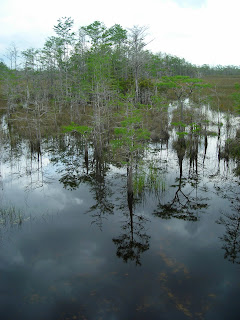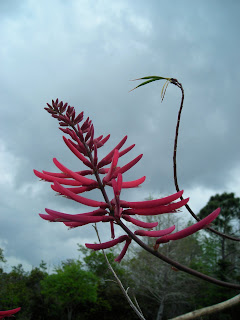Join the Blog Team
 | ||||||||
| Cypress head at Grassy Waters Preserve |
Shock and awe would just about describe the feeling I had yesterday as I came across a brand new shopping center here in Virginia which had to cover, in a conservative estimate, about 30 acres. Imagine
it - 30 acres completely covered by parking and buildings without a single plant or pervious surface of any kind. I mean not one! With all we know now about best practices. And I had to wonder: why are people surprised that heavy rains have made rivers here overflow, causing massive damage to property and life. Homes are flooded, cars have been swept away, waste water treatment plant overflows have caused campgrounds on rivers to be closed.
Stormwater runoff. I think we talk about it more in Florida than some other states do. But it’s a concept that everybody needs to understand. We can’t always have what we want! We have to pay attention to the changes we are making to our environment, changes that cancel the ecosystem services that we absolutely depend on. Those would be fresh water, oxygen, carbon sequestration, erosion and flood control, small details like that.
Are you wondering what all this has got to do with Florida native plants? Well, it’s like this. Nothing in life is certain but change, and change has lead me to a new address here in the Old Dominion State.
Stormwater runoff. I think we talk about it more in Florida than some other states do. But it’s a concept that everybody needs to understand. We can’t always have what we want! We have to pay attention to the changes we are making to our environment, changes that cancel the ecosystem services that we absolutely depend on. Those would be fresh water, oxygen, carbon sequestration, erosion and flood control, small details like that.
Are you wondering what all this has got to do with Florida native plants? Well, it’s like this. Nothing in life is certain but change, and change has lead me to a new address here in the Old Dominion State.
The thing I am going to miss the very most is the Florida Native Plant Society, where I have met so many wonderful people, and from them, learned so much about the natural world we live in.
My interest when I first joined the Society, was in native plants. But the Society’s mission extends beyond plants to include “native plant communities.” As my knowledge expanded, I began to appreciate the complexity and wealth of native plant communities, and to understand their value in supporting ecosystem services such as those above. I also began to want to share with others these new-to-me ideas, and to teach others about the contributions they could make to a greener world by using and conserving native plants.
My interest when I first joined the Society, was in native plants. But the Society’s mission extends beyond plants to include “native plant communities.” As my knowledge expanded, I began to appreciate the complexity and wealth of native plant communities, and to understand their value in supporting ecosystem services such as those above. I also began to want to share with others these new-to-me ideas, and to teach others about the contributions they could make to a greener world by using and conserving native plants.
Both the learning and the sharing have been great joys.
In February of 2010, a blog seemed to me like a great way to share information about native plants, and the FNPSblog was born. A Facebook page and Twitter account were naturals at that point, so web-genius Cindy Liberton set all that up for us. Ginny Stibolt quickly evolved into a real workhorse of a partner, and now, here we are 176 posts later. Do you see where this is leading? Well, you are right. I am now extending an invitation to you, to partake of the special joys of writing about the native plant world, and to become part of the blogging team.
In February of 2010, a blog seemed to me like a great way to share information about native plants, and the FNPSblog was born. A Facebook page and Twitter account were naturals at that point, so web-genius Cindy Liberton set all that up for us. Ginny Stibolt quickly evolved into a real workhorse of a partner, and now, here we are 176 posts later. Do you see where this is leading? Well, you are right. I am now extending an invitation to you, to partake of the special joys of writing about the native plant world, and to become part of the blogging team.
We need help with writing articles, interviewing people, and getting the word out about all the neat things people and groups are doing these days. Many hands make light work, and it truly, truly is an enjoyable and satisfying activity. If you'd like to join the blog team, or have suggestions about others who might be able to help, please send us an email at:
fnps.online@gmail.com
Write to us, write for us, and help us spread the word: native plants add LIFE to your landscape, wherever it may be!
sue dingwell
 |
| Erythrina herbacea Coralbean or Cherokee bean |



Comments